Design Meta, governing data administration
Contents & topics Data governance
Metadata at an organization by layers.

Metadata, what is in it?
Just having data, there are a lot of questions to answer:
📚 Information data is describing?
⚙ Relationships data elements?
🎭 Who is using data for what proces?
⚖ Inventory information being used ?
🔰 Most logical
back reference.
Contents
| Reference | Topic | Squad |
| Intro | Metadata at an organization by layers. | 01.01 |
| data_env | Setting of a Data environment. | 02.01 |
| rZ_revZ | New business data or maintaining one. | 03.01 |
| daddy | Describing data - information. | 04.01 |
| uml_meta | Describing descriptions of data. | 05.01 |
| What next | Step by step, Travelling the unexplored. | 06.00 |
| | Following steps | 06.02 |

Combined pages as single topic.
👓 deep dive
, Data Proces layers
🚧 describe data
,Data Administration
👓 Data Modelling
👓 Security Access
Progress
- 2019 week:18
- Conforming temporary page. Just headers - topics to do.
From old page security desing to rework.
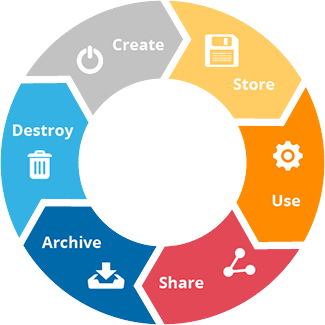
Setting of a Data environment.
A Data environment is having several lines, development & operational.
The development line (top ltr) is using development tools.
Those data, tools and the used infrastructure (machines, os) should be tested and verified with "user acceptance".
The user acceptance is done by dedicated test staf, being representive for intended users of data.
Once a file is created, it is stored and then used. During this stage, critical data is viewed, processed, modified and saved.
You need to be able to monitor user activity and apply role-based security controls to ensure data leak prevention.
The compelete figure is:
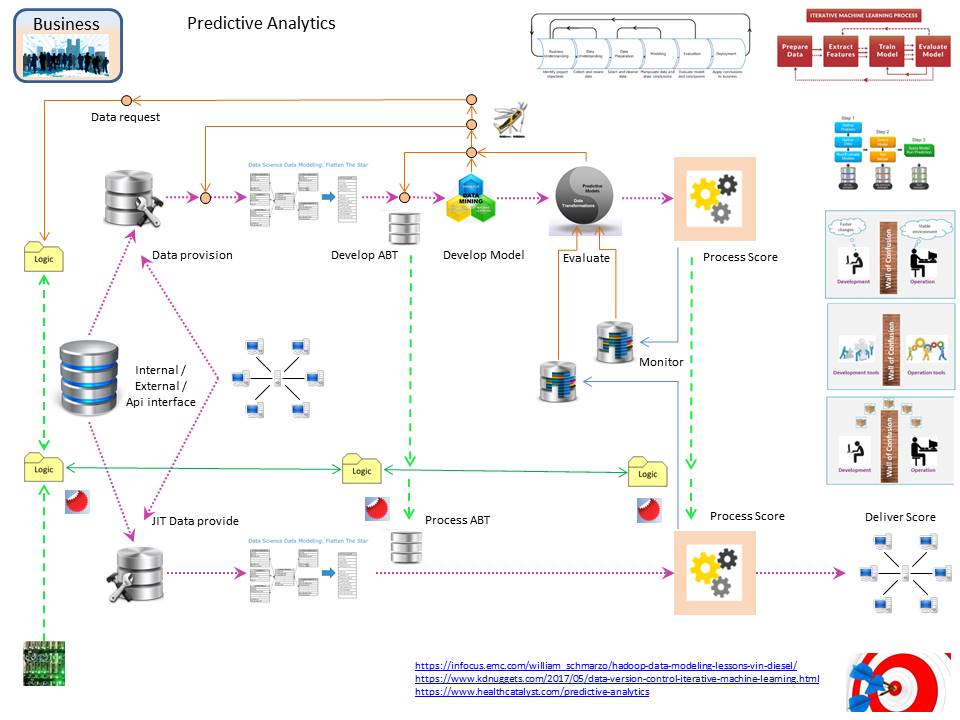
A good collaboration by
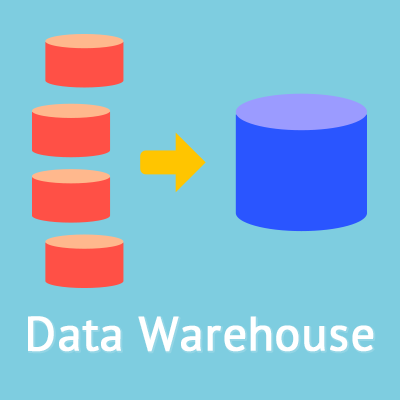
to

(operations) and

(development)
is a prerequisite to achieve the wanted situation of easy, simple, quick, reliable trustworhty data deliveries (agile).
Using existing infrastructure has the requirement: verification that it is sufficiënt for what is going to get build.
It can save a lot of time and hard word. The disadvantage being felt is sharing infrastructure.
The containerization is proving it not an disadvantage but an advantage when done correctly. That is at the business customer delivery line.

New business data or maintaining one.
Delivering releases over all layers has two possible starting points. The difference: creating a new application or changing an existing.
Data new project - rZ
Needing a own new infrastructure starts at building up that. (top green)
Having infrastructure, building the business application can start (blue diagonal).
After the first delivery the improvement (orange bottom) proces can start.
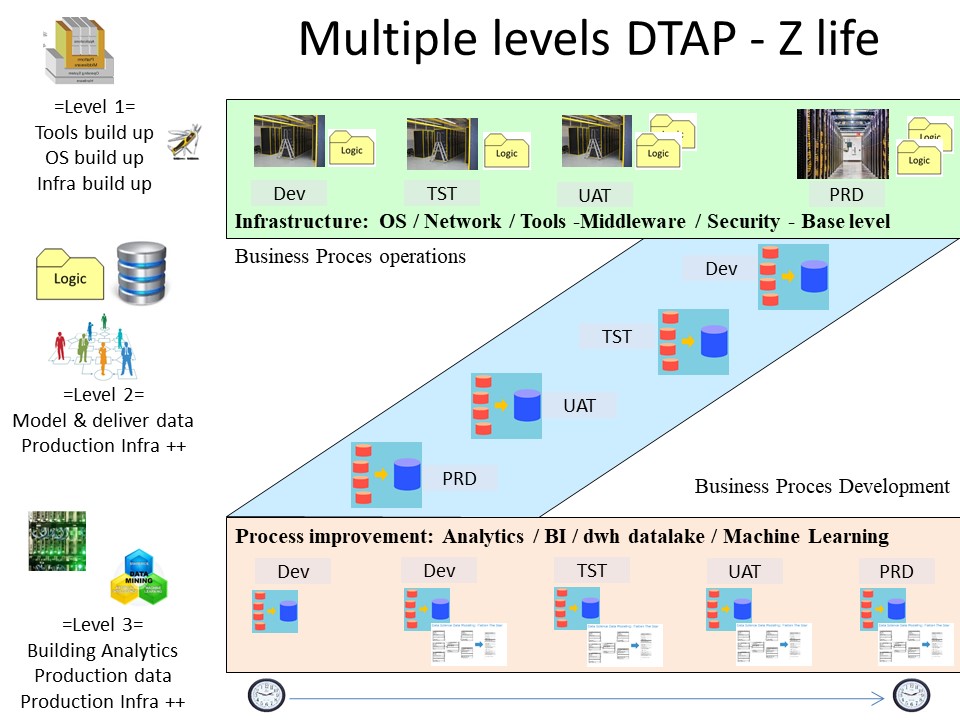
Data maintenance project - revZ
At an existing situation several starting points are possible:
- determining improvements (orange top ltr)
- Changing the business data by a vmap approach (blue diagonal).
- Changing infrastructure supporting the applications(bottom green)
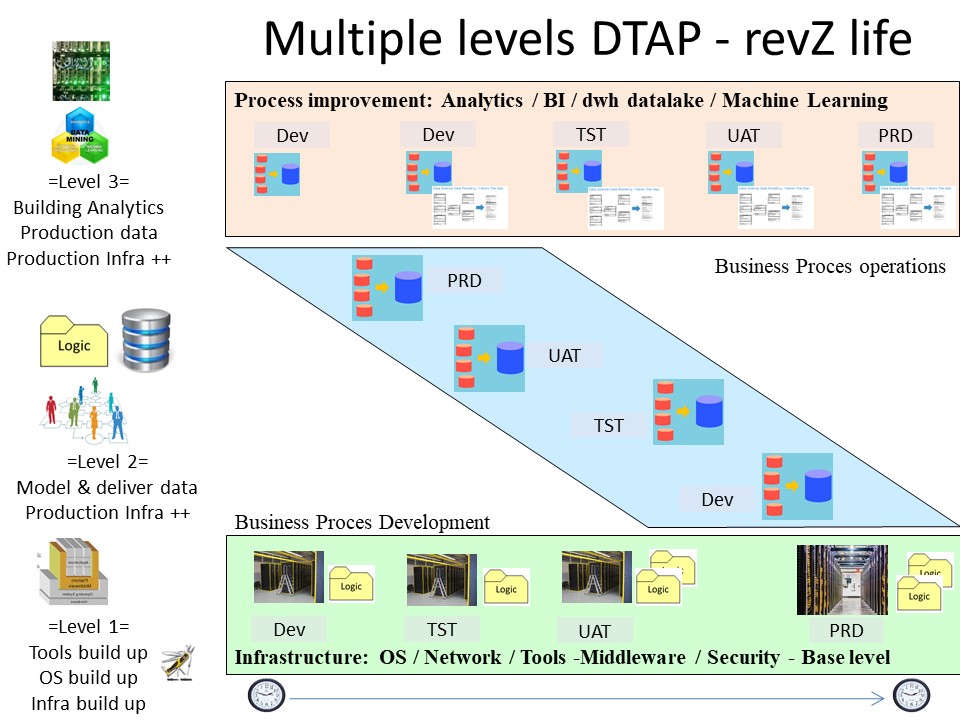

Describing data - information.
Describing information in natural language, the goal: everybody has the same understanding, is not easy,it is extremely difficult.
A glossary at a document is commonly needed for that.
Within ICT there is a lof of Confusion, Conflicts, Chaos (CCC).
CCC: Logic (code)- Data (information)
⚠ A workable correct definition on "Business Logic" is confusing as it not exact the same as an implementation in code using some software language.
Datasets, tables are possible input for logical decisions, in that case the existance of a data table and /or the content of a daasets is becoming possible "business logic".
By that schould fall into the versioning and release management of "business logic". Promoting versioning of decision tables, metadata artifact descriptions.
⚠ A workable correct definition on "Business Information" is confusing as it not exact the same as an implementation in datasets - databases.
Data segments in the code by a language acting as Information. Examples: a different date/time provision, default IBAN number for internal validations, defining a legal signature. Software becoming "business information".
By that schould fall into the datamanagement of "business information".
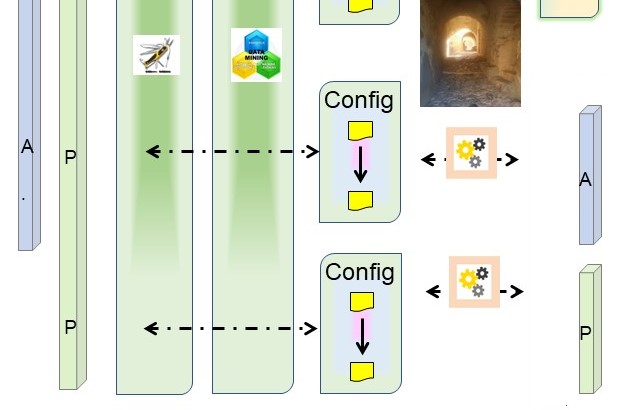
🤔 If it is not "business logic" and not "business information" another option?
Operations staf have their own sdlc, meta and data for processing, administration. Well visible at production (P) and user accpetance (A).
Another option: hardcore ICT tasks. For example: network firewalls, routers, SOC with monitoring & alerts.
CCC: Using data describing the data processing.
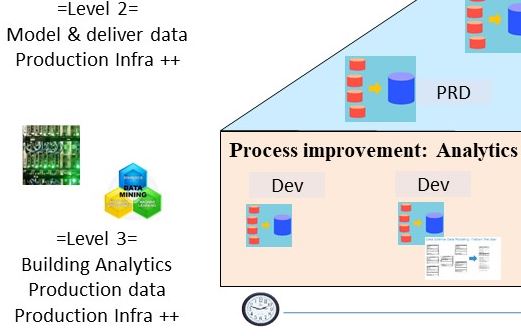
A switch in normal business processing and analyzing businesses processes (BIAnl) is there. BIAnl will need business production data for developing reports -analytics.
💣 classic ICT staf will block that.
The technical data connection is the only stage not needing business production data (BIAnl).
Naming conventions
Data element name (wikpedia, iso 1170)
A data element name is a name given to a data element in, for example, a data dictionary or metadata registry.
In a formal data dictionary, there is often a requirement that no two data elements may have the same name, to allow the data element name to become an identifier,
though some data dictionaries may provide ways to qualify the name in some way, for example by the application system or other context in which it occurs.
In a database driven data dictionary, the fully qualified data element name may become the primary key, or an alternate key, of a Data Elements table of the data dictionary.
The data element name typically conforms to ISO/IEC 11179 metadata registry naming conventions and has at least three parts:
Object, Property and Representation term.

Describing descriptions of data.
"Data administration" is describing artifacts and object in understandable natural language wiht the goal avoiding confusion.
The most simple being the most complex.
artifacts models.
(1) A person can have roles: name, address, place of residence, payer, insured object, risk bearer, responsible, first name, last name, employee, executor, managing, writer, author, born, gender, traveling, was present at, host etc.
(2) A date is even more complex, it is additive to an event and there are a lot events. The date-utc itself is not stnadardized there are lot of conetions. Doing time travelling then working days holidays intervals, leap year. Nothing is consistemen betweeen differnt years.
Trying to describe all those is very challenging. More easy is to buy standard software having the business models and data models already predefined (ERP COTS Commercial Of The Shelf software).
CCC: retention policies documents.
document-retention-policy (science direct) Some text:
(1)
Any computer-related crime requires sensitivity to timeliness of evidence identification and collection.
The Order of Volatility applies to data that naturally becomes unavailable in time due to natural processes such as shutting off a computer.
It also applies to data that is intentionally deleted through normal business operations or computer use.
(2)
A comprehensive information management program is the cornerstone of a successful e-discovery process.
However, while the vast majority of communications and business activities today take place in an electronic environment, many enterprises do not have document retention programs and policies in place to appropriately address how ESI is created,
managed, and disposed. Fewer organizations have the tools to effectively enforce their information policies and, as a result, struggle with the discovery process.
Because a good information management program addresses all types of business records, whether electronic or not,
and since electronically stored records are the dominant form today, the use of information technology systems is critical to the effective management of information.
A document and record in the context of "retention policy" is not the technical materalization in a DBMS or file storage by a wordprocessor.
It is about any kind of information.
Ontlology RDF - XML xsd meta schema
ontology (w3c referers to RDF-JSON )
On the Semantic Web, vocabularies define the concepts and relationships (also referred to as "terms") used to describe and represent an area of concern.
Vocabularies are used to classify the terms that can be used in a particular application, characterize possible relationships, and define possible constraints on using those terms.
In practice, vocabularies can be very complex (with several thousands of terms) or very simple (describing one or two concepts only).
XML XMI (omg.org xsd schema xml documents)
An XML schema provides a means by which an XML processor can validate the syntac and somen of the semantics of an XML docuement.
This International Standard provides rules by which a schema can be generated for any valid XMI-transmissable MOF-based model.
However, the use of schema's is optional: an XML document need not reference a schema, even if one exists.
The resulting document can be processed more quickly, at the cost of some loss of confidence in the quality of the document.

Step by step, Travelling the unexplored.
💣 Metadata, Integrated Data Dictionary (IDD), is different way of generating code. Code generation using metadata as input is switching to the meta database as the source for generated code (5 GL).
A misfit to code version tools like git (3 GL)
CCC: managing data operational - DBA
Developing the operational business processes (on premise) the role of DBA is logical in the technical solutions.
- DML, Data manipulation language. Storing records adding changing deleting is the only action a DBA is allowing others to do.
- DDL, Data definition languge. Logical (records tables), Performance (indexes) and technical (Storage and staroge performance).
- MDL, Metadata definition language. The description, metadata of metadata, embedded security, external connections.
⚠ In the area of BIAnl the role of a DBA it is a problematic one. The request is changing data delivering new reports, doing analytics fast. Needing DDL MDL within developpers toolset.

Visiting all stages (dimensions).
Making a journey to all layers and all stages is exploring where no one has gone before.
The people at the hardcore ICT infrastructure are a different kind of species than the ones servicing the business.
Understanding the business and those people is another world.
Combined pages as single topic.
 🔰
🔰 Most logical
back reference.
 Metadata, what is in it?
Just having data, there are a lot of questions to answer:
Metadata, what is in it?
Just having data, there are a lot of questions to answer:


 to
to  (operations) and
(operations) and  (development)
is a prerequisite to achieve the wanted situation of easy, simple, quick, reliable trustworhty data deliveries (agile).
(development)
is a prerequisite to achieve the wanted situation of easy, simple, quick, reliable trustworhty data deliveries (agile).



 🤔 If it is not "business logic" and not "business information" another option?
🤔 If it is not "business logic" and not "business information" another option? A switch in normal business processing and analyzing businesses processes (BIAnl) is there. BIAnl will need business production data for developing reports -analytics.
A switch in normal business processing and analyzing businesses processes (BIAnl) is there. BIAnl will need business production data for developing reports -analytics.
